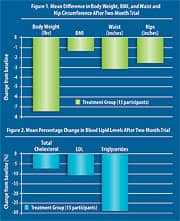Life Extension Magazine®
Even when faced with life-threatening diseases related to their corpulence, most overweight people simply cannot manage to eat less. One overlooked reason for today’s obesity epidemic is a stress-induced disorder known as “emotional eating.” Consuming certain foods, especially high-glycemic carbohydrates, bolsters “feel-good” brain neurotransmitters such as serotonin that are depleted by stress.1 While increasing brain serotonin levels through high-carbohydrate meals can help elevate mood in the short term, ingesting ever-greater amounts of dietary carbohydrates often leads to weight gain and a cascade of ill health effects throughout the body. To stand any chance of success, programs designed to help people reach and maintain an optimal body weight must address the multifaceted biochemical and psychological processes that contribute to excess weight gain. Fortunately, nutritional scientists have identified a combination of novel nutrients that disrupt these processes in multiple ways—suppressing brain chemicals that trigger the urge to overeat, activating hormones that convey to the brain a sense of satiety and fullness, and optimizing metabolic processes that contribute to increased fat burning and lean body mass. In this article, we explore how these nutrients attack the multiple mechanisms that promote unwanted weight gain, and describe the results of a Life Extension clinical study designed to demonstrate their efficacy when used in conjunction with a comprehensive weight-loss strategy. How Emotions Trigger Food CravingsIt’s happened to everyone. Most of the time, we are able to successfully control our food intake. We select vegetables and fruits with a high nutritional value. We take care to consume sufficient amounts of lean protein and fiber. We balance our caloric intake with our daily caloric expenditure in a way that ensures a stable body weight. Then something happens to make us stressed or depressed—and we head straight for the Häagen-Dazs. Scientists refer to this phenomenon as emotional eating—a way that many people cope with negative feelings like depression, anxiety, stress, and boredom. People who normally restrain their food consumption lose self-discipline when faced with stressors that seem beyond their control. This pushes them to make dietary choices that are detrimental in the long term, but that in the short term offer immediate gratification and relief (albeit temporary) from negative emotions. In fact, several studies have shown that people under chronic stress tend to gain weight over time, due to both stress-related endocrine changes and aberrant coping behaviors that center on food. In general, scientists have found that eating a meal alters your mood and emotional predisposition, typically reducing irritability and increasing calmness.1 A study in Psychosomatic Medicine confirmed that people tend to consume food in order to self-medicate their feelings of stress or anxiety.2 Thirty-four men and women were told that they needed to prepare a four-minute speech that would be recorded by video equipment and later assessed by the researchers for its quality. This produced so much stress in the participants that their blood pressure increased and their mood worsened. An additional 34 volunteers served as a control group. All participants were then allowed to eat as much as they wanted of a selection of foods. The outcome? The stressed group consumed 88% more sweet, fatty food than did the control group. Another study found that the most important psychological variable that determines how much ice cream people consume is their tendency toward emotional eating.3
The winter holidays often make emotional eating even worse. According to a recent survey by the American Psychological Association, 41% of women eat for comfort during the holidays, compared to 31% who do so during the rest of the year.4 Among men, 25% report comfort eating over the holidays, compared to 19% who do so the rest of the year. These results are closely related to stress levels: 44% of women and 31% of men report increased stress during the holiday season. Clearly, increasing one’s food consumption is a very common coping mechanism for both men and women. Scientists believe these choices are not made solely because of the pleasing taste of these foods. Carbohydrate-rich, protein-poor meals allow greater uptake of the amino acid tryptophan into the brain, where it serves as a precursor for synthesis of the brain neurotransmitter known as serotonin.5 Consuming these foods can also relieve stress by stimulating the release of brain opioids known as endorphins, which induce a sense of pleasure, and dopamine, another brain neurotransmitter that underpins the positive reward system, including the anticipation of pleasure.6,7 While this eating strategy may be useful in reducing feelings of stress in the short term, chronic intake of these foods can lead to weight gain and other health-damaging effects. Peptides and hormones such as cholecystokinin (CCK), glucagon-like peptide-1 (GLP-1), leptin, and peptide YY (PYY) can also influence hunger levels, sometimes triggering increased food intake—whether you need the calories or not.8 Successful manipulation of these neurotransmitters, hormones, and peptides can therefore help prevent episodes of emotional eating, reducing the impact of a stressful lifestyle on your waistline. In the long run, continued management of these variables can ensure that you are able to achieve and maintain a healthy body weight that will contribute to a longer life. As health-conscious adults seeking to live long and productive lives, we need to learn how to manipulate these signals our brains receive in a way that will allow us to control our caloric intake. Life Extension’s scientists have identified three critical nutrients—green oat extract, pinolenic acid, and conjugated linolenic acid (CLA)—that can help us achieve this goal. These nutrients work together to promote satiety—the condition of being full to the point of satisfaction—while reducing the tendency toward emotional eating, enabling us to adhere to a healthy diet that promotes health and longevity. Green Oat Extract Inhibits Troublesome Brain ChemicalsOne natural product that has shown great promise in easing emotional stress and nervous energy is green oat extract. This botanical agent positively influences your brain chemistry by increasing the action of two chemical messengers that enhance positive feelings, helping you to resist tempting foods. Its invigorating actions also promote a sense of well-being that can help strengthen your will power to follow a healthy diet and lifestyle program. Wild oat (Avena sativa) has been used for thousands of years as both a food and medicinal agent. As early as the Middle Ages, herbalists recommended green oat to enhance mood and promote a sharp, clear mind. In the past decade, the German Commission E Monographs—a leading authority on modern herbal medicine—noted that this botanical remedy helps reduce stress, anxiety, and tension. Green oats are also considered useful as a tonic and restorative remedy to treat nervous exhaustion.9 Today, scientists are uncovering the mechanisms by which green oat extract works to relieve stress and promote well-being. Laboratory studies have found that wild oat extract significantly inhibits two enzymes that are closely related to mood states: monoamine oxidase B (MAO-B) and phosphodiesterase-4 (PDE4).10,11 MAO-B is responsible for the breakdown of dopamine, and drugs that lessen its activity are frequently used to treat symptoms of depression.12 Inhibiting PDE4, on the other hand, helps to boost levels of cyclic AMP (cAMP), an important secondary chemical messenger in cells.13 This may help promote the positive feelings that can decrease emotional eating. By promoting mental and physical resilience and reducing nervous tension, wild green oat extract thus disrupts the link between emotional stress and the urge to raid the refrigerator.
| ||||







